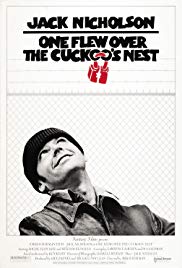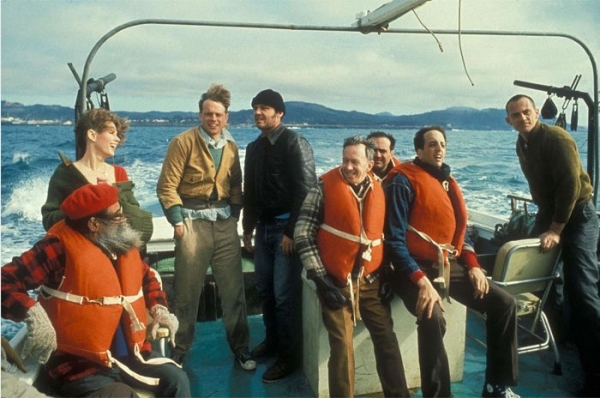ONE FLEW OVER THE CUCKOO’S NEST
Deriving Theme – Using the Fishing Scene
Subject: Literature/Literary Devices: Theme
Ages: 12+
Length: Snippet: approximately 14 minutes; Lesson: one 45 – 55 minute class period.
There is NO AI content on this website. All content on TeachWithMovies.org has been written by human beings.

Deriving Theme – Using the Fishing Scene
Subject: Literature/Literary Devices: Theme
Ages: 12+
Length: Snippet: approximately 14 minutes; Lesson: one 45 – 55 minute class period.
Using the Snippet in Class:
Students will practice deriving theme from a scene in a novel that has been adapted to film.
The scene is a powerful presentation of a thematic concept. In addition, students reading Ken Kesey’s novel will enjoy seeing the film’s presentation of this important scene.

In this classic scene from One Flew over the Cuckoo’s Nest, Randall Patrick McMurphy, played by Jack Nicholson, takes fellow inmates of the mental institution on an unauthorized fishing trip. Although in the novel by Ken Kesey, McMurphy manipulates the situation by organizing the outing and making a tidy profit for himself, in the film he simply absconds with a bus full of inmates, picks up his girlfriend and hijacks a fishing boat. The joyful energy spent catching the fish shows on the faces of the inmates; they have become happy, successful men rather than the troubled spirits they are at the hospital. Whether or not students read the book or see the entire movie, the snippet illustrates one of the film’s ideas: society determines what is crazy and what is not crazy and this determination is created through observable behavior; in other words, crazy is as crazy does.
1. Review the film clip.
2. Cue the DVD so that the film clip will start immediately.
1. Define the term “theme” using a definition that you have found works for your students. Be sure they understand that a theme is a theory or hypothesis about life or human nature which the author or filmmaker believes to be universally true.
2. As an introduction to the theme of the clip, albeit it not in terms of lunatics in an asylum, students can engage in a bit of role playing. Ask them to assume the physical appearance of an honors student. Tell them that a Harvard scholarship official is here to grant full paid tuition to someone who looks the part of a scholar. Kids will sit up straight, lean forward and look awake when affecting the role of good students. Next tell them that a casting director is here to select students to act bored or angry or disinterested. Students will then slump or pretend to doze when affecting the role of less than stellar students. As the teacher, you can mention how their body language affects the way you view them in terms of potential academic performance. 3. If the class is not reading the book, briefly summarize the lead up to the scene, at least telling them that McMurphy pretends to be insane in order to be committed to a mental hospital to avoid being jailed on a minor criminal charge. Unable to abide by the rules of the hospital, McMurphy does a number of outrageous things, one of which is to take the inmates of his ward on an unauthorized fishing trip.
4. Show the film clip.
5. Discuss how the pictures shown in the film clip reveal how the inmates have changed during the trip.
6. Ask students to state a theme of the film clip in their own words.
Teacher’s Note: Guide the discussion so that students recognize that the theme of the scene is that insanity is a social construct. Society determines what is crazy and what is not crazy and this determination is created through observable behavior. In other words, crazy is as crazy does. Your students may have different ways of wording this idea, but in the snippet, they will see how the men from the asylum stop being lunatics when they stop behaving as lunatics and are then not seen as lunatics by society in general. Insanity is a judgment passed by observers who evaluate according to social norms. In the film as a whole, this is the central thought; McMurphy was never insane, he pretended to be insane to get out of jailhouse work. Then, in the institution, he was seen as insane because of his refusal to conform to the rules.
7. Concluding Writing Assignments: Select one of the following prompts depending upon whether or not your students are reading the novel, and ask students to cite specific moments or images in the snippet to support the point they are making in their essay. Use the standard rubric students have become accustomed to in your writing assignments. Be sure to tell students how long a response you expect from them.
Play the clip again after giving the assignment.
This Snippet Lesson Plan was first published on January 21, 2012, and
last revised on March 17, 2012. It was written by Mary RedClay.